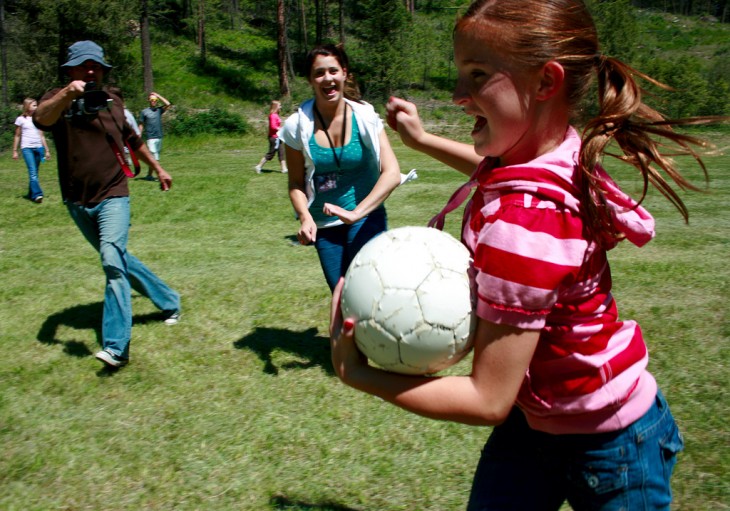
This post originally appeared on the Crew blog.
Andrea wrote a great post about working remotely recently. There’s something implicit in her post that I’ve noticed in my own work: even when you’re working in a mostly “solo” position (e.g. as a writer), being part of a team means your job will always entail some degree of collaboration.
Whether you work remotely or in an office, no doubt you collaborate in various ways every day. From asking your colleagues for feedback to brainstorming a new project together, collaboration is something we often do without even thinking about how it works.
How we learn to collaborate
Have you ever noticed how kids tend to work together to get things done or set up their games, without ever being shown how, beyond generic “play nicely” instructions?
Of course, kids learn how to collaborate with others from an early age, but part of it also tends to come naturally. Unlike closely related species like chimpanzees, we humans seem to be born with an intrinsic motivation to collaborate with others.
Though kids are drawn to work with others, they most often work or play together in small groups—especially pairs. Pair games were the focus of a study on the collaborative skills of popular and unpopular children, which offered some insights into how we learn better collaborative skills like improved communication.
When unpopular children were paired up, they argued and broke the game rules more often. They also spent little time looking at their partner’s face, and missed facial cues about their partner’s feelings.
Pairing up an unpopular child to a more popular one meant the unpopular child took more cues from their partner—they argued less, smiled more and looked at their partner’s face more. Popular female children, in particular, tended to make allowances for their partner’s need for support during the game.
This study shows how strongly we’re influenced by the behavior of others when we’re kids, and how innate our collaborative tendencies are.
Brainstorming
In my experience, brainstorming has always been a classic example of part of my workflow that includes collaboration. Bouncing ideas off other people can lead to more ideas, better ideas, and help you to explore ideas from different points of view.
I was surprised to find that brainstorming shouldn’t always be a group activity. In a group, we don’t usually come up with our best ideas because we’re stifled by rules (like not debating new ideas, which is actually a good way to improve them) or by the pressure of sharing ideas with people in higher authority than us.
What tends to work best for brainstorming is a split approach: start in a group to discuss your objectives and get some ideas flowing, then break off into pairs or individuals for more constructive free thinking. Finally, come back into a group discussion, with everyone sharing ideas they came up with alone.
Healthy debate and reworking these ideas together can lead to the most creative brainstorming results.
Why we work with others
Many of us could get away with doing most of our work alone, but there are benefits to be had from collaborating with others. For starters, it can be beneficial to simply have another pair of eyes on your work. Feedback is often critical to the creative process, especially if you want to produce the best work you’re capable of.
Beyond simple feedback, there are benefits to working alongside others. Collaborative learning, for instance, can improve students’ performance on cognitive thinking tasks. And in the workplace, the more a team member feels their team is working together, the higher their job satisfaction is likely to be, the more they’ll learn at work, and the better the team’s overall performance will be.
That’s pretty solid evidence for encouraging collaboration in your team, I’d say. And you can take heart in the fact that we’re predisposed to want to collaborate, so it shouldn’t be too hard to get some teamwork happening.
Increasing collaboration at work
To encourage team members to work together, you can alter the structure of the team so they rely on each other more, or simply design work projects in a way that encourages teamwork. For instance:
- Create self-directed teams by breaking off small groups and giving them a goal to work towards. Let each group self-manage or choose their own leader to manage the team.
- Apply the split approach to other creative processes besides brainstorming. Start out with a group session to get everyone on the same page, then allow everyone time to work alone or in pairs before returning to the group to share their work.
- Encourage team members to ask each other for feedback before turning to a manager or team leader. Receiving feedback can improve performance and uncover potential areas for improvement that might otherwise be missed.
Most importantly, understand your team members and how they like to work. One article I read suggested working in an open office or a coworking space to encourage collaboration, but open offices are known for being harmful to productivity and employee happiness.
Encouraging collaboration can be beneficial for your team members, so long as you do it wisely.
Get the TNW newsletter
Get the most important tech news in your inbox each week.






